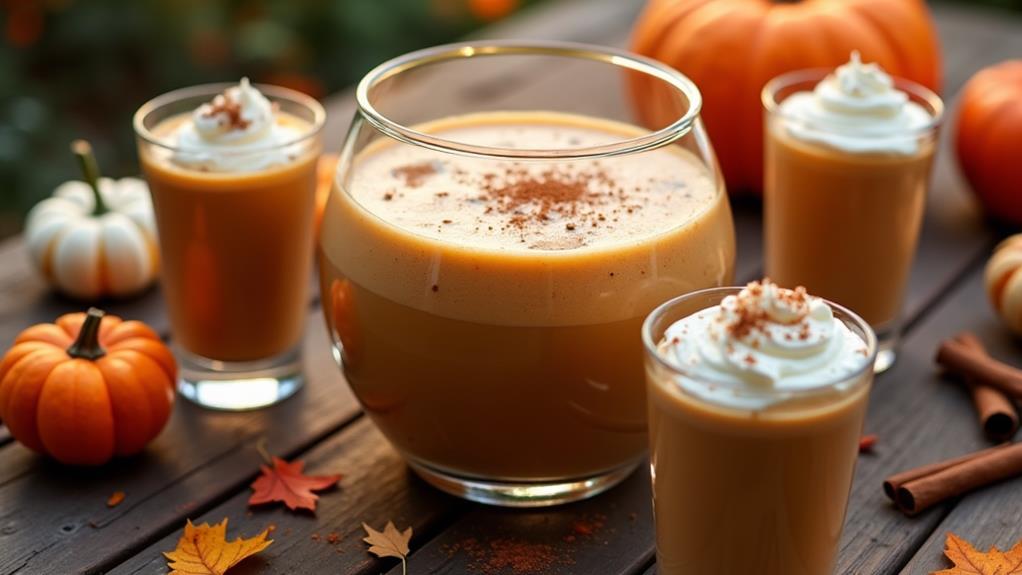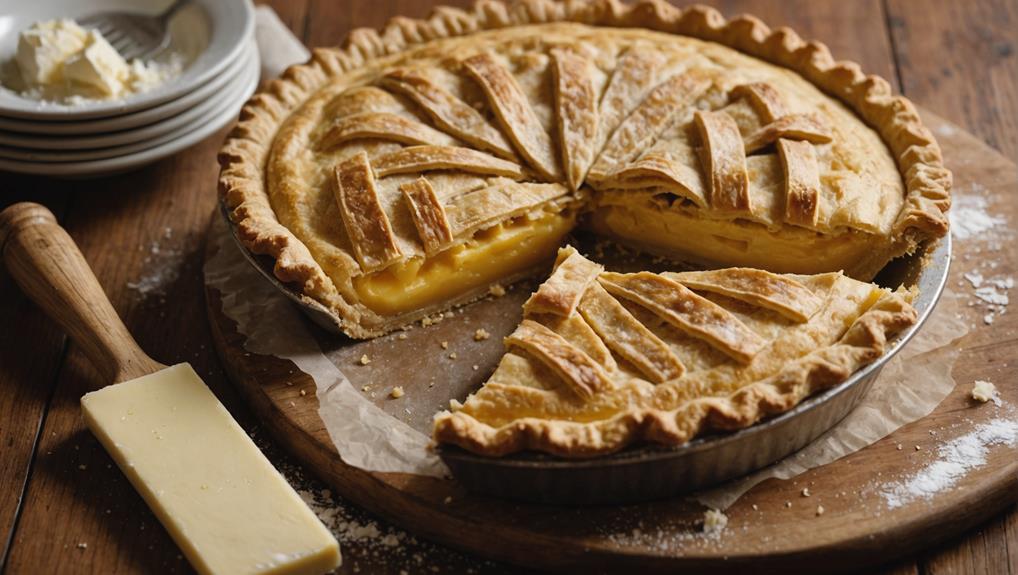You've likely encountered the Decadent Chocolate Yule Log at holiday gatherings, but do you know the rich history behind this festive dessert? This rolled cake, resembling a log and often dusted with cocoa powder, isn't just a treat for the taste buds—it's a nod to ancient traditions. While it may seem daunting to create, you'll be surprised to learn that this impressive centerpiece requires only five key ingredients. As you consider adding this dessert to your holiday menu, you might wonder about its origins and the secrets to crafting the perfect chocolate log.
Key Takeaways
- The Decadent Chocolate Yule Log is a classic French dessert featuring rich chocolate cake rolled with cream filling.
- It requires only five key ingredients: eggs, sugar, flour, cocoa powder, and heavy whipping cream.
- The cake is baked, rolled while warm, filled with whipped cream, and decorated to resemble a log.
- Cocoa powder dusting and textured frosting create a bark-like appearance for a festive woodland theme.
- This dessert combines simplicity in preparation with impressive visual appeal, making it ideal for holiday gatherings.
History
The origins of the Yule Log cake date back to medieval Europe. You'll find its roots in the ancient Celtic tradition of burning a log during the winter solstice to ward off evil spirits and bring good luck for the coming year. As Christianity spread, this pagan custom evolved into a Christmas tradition.
In the 19th century, French bakers transformed the concept into an edible dessert. They created a cake that resembled a miniature Yule log, complete with bark-like frosting and woodland decorations. This confectionery masterpiece, known as Bûche de Noël, quickly became a beloved holiday treat across France and beyond.
You'll appreciate how the cake's design reflects its history. The rolled shape mimics the log's cylindrical form, while the chocolate frosting represents the bark. Meringue mushrooms and marzipan holly leaves often adorn the cake, paying homage to its forest origins.
Today, you'll find countless variations of the Yule Log cake, each adding its own twist to this time-honored dessert. It's a delicious way to celebrate the holiday season while honoring centuries of tradition.
Recipe
The Decadent Chocolate Yule Log, or Bûche de Noël, is a classic French dessert that embodies the warmth and elegance of the holiday season. This simplified version of the traditional recipe uses just five ingredients to create a rich, moist chocolate cake with a luscious cream filling, all rolled into the shape of a festive log.
While the original recipe can be quite intricate, this streamlined approach focuses on high-quality chocolate and key components to achieve an impressive result. The combination of cocoa powder in the cake and whipped cream filling creates a perfect balance of flavors, making this dessert a showstopper at any Christmas gathering.
- 4 large eggs
- 1 cup (200g) granulated sugar
- 1/2 cup (60g) all-purpose flour
- 1/3 cup (30g) unsweetened cocoa powder
- 1 cup (240ml) heavy whipping cream
Preheat the oven to 350°F (175°C) and line a jelly roll pan with parchment paper. Separate the eggs and beat the yolks with sugar until pale and creamy. In a separate bowl, whip the egg whites until stiff peaks form.
Sift together the flour and cocoa powder, then gently fold into the egg yolk mixture. Carefully fold in the egg whites, then spread the batter evenly in the prepared pan. Bake for 12-15 minutes until the cake springs back when touched.
While still warm, roll the cake with the parchment paper inside to create the log shape. Once cooled, unroll and spread with whipped cream, then re-roll without the paper. Dust with cocoa powder to create a bark-like appearance.
For best results, chill the cake for at least an hour before serving to allow the flavors to meld and the cream to set. To enhance the woodland theme, consider adding meringue mushrooms or marzipan holly leaves as decorations.
Remember that the key to a successful roll is to work quickly while the cake is still warm and pliable, preventing cracks and ensuring a tight spiral. If desired, you can also add a thin layer of chocolate ganache over the rolled cake for extra richness and to further enhance the log-like appearance.
Cooking Steps
To create your Chocolate Yule Log, you'll begin by separating the eggs and beating the yolks with sugar until creamy, while whipping the whites to stiff peaks in a separate bowl.
Next, you'll combine the dry ingredients and gently fold them into the egg mixture before spreading the batter in a prepared pan and baking until springy.
Once baked, you'll quickly roll the warm cake with parchment paper, then unroll it when cool to spread with cream before re-rolling into its final log shape.
Step 1. Separate Eggs and Beat Yolks
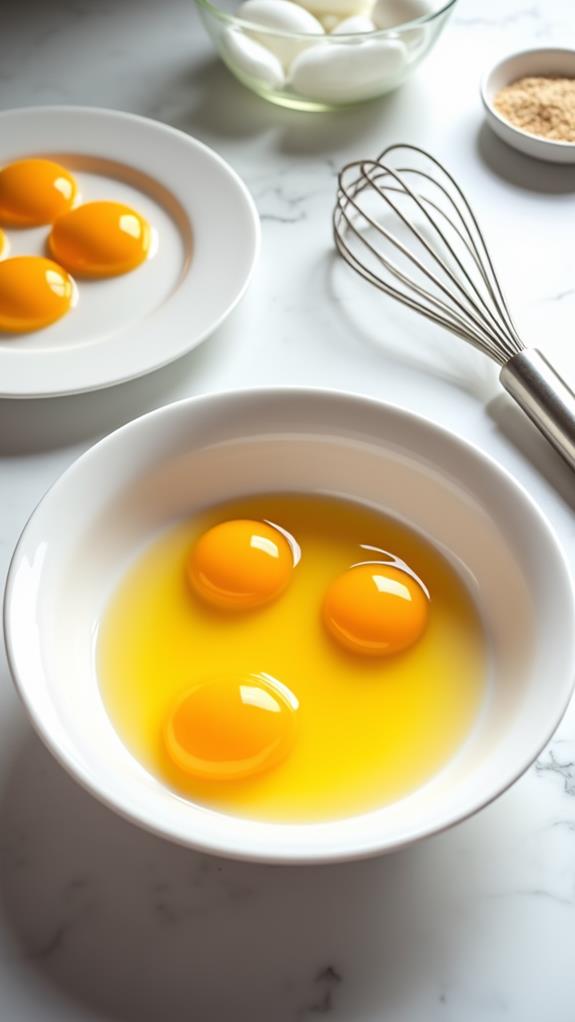
First, carefully separate the four large eggs, placing the yolks in one bowl and the whites in another.
You'll want to ensure there's no yolk in the whites, as this can affect their ability to whip properly.
Once separated, add the granulated sugar to the bowl with the egg yolks.
Using an electric mixer or a whisk, beat the egg yolks and sugar together vigorously.
You're aiming for a pale, creamy mixture that's significantly lighter in color than when you started.
This process, known as "ribbon stage," is crucial for creating a light, airy cake.
As you beat, you'll notice the mixture becoming thicker and increasing in volume.
When you lift the whisk or beaters, the batter should fall back into the bowl in a ribbon-like stream and hold its shape for a few seconds before dissolving.
This typically takes about 3-5 minutes with an electric mixer or 7-10 minutes if you're whisking by hand.
Don't rush this step; it's essential for the cake's structure and texture.
Step 2. Whip Egg Whites Until Stiff
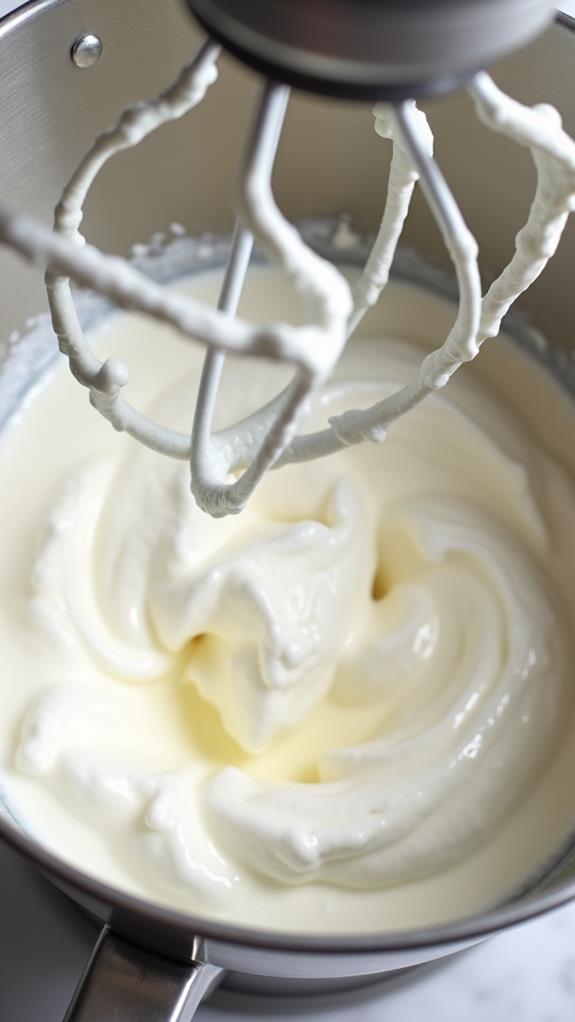
Precision is key when whipping egg whites to stiff peaks. You'll need to separate the whites from the yolks carefully, ensuring no yolk contamination, which can prevent proper whipping.
Start with room temperature egg whites for best results. Using an electric mixer or stand mixer, begin whipping the whites on medium speed until they become foamy.
As you continue beating, gradually increase the speed to high. You'll notice the whites becoming opaque and increasing in volume. Look for soft peaks forming when you lift the beaters.
At this stage, if you're adding sugar for meringue, do so gradually while continuing to whip. Keep beating until the peaks stand straight up when you lift the beaters, and the mixture looks glossy and stiff.
Be careful not to overbeat, as this can lead to a dry, grainy texture. To test for stiff peaks, turn the bowl upside down. If the whites don't slide or move, you've achieved the perfect consistency.
This stiff egg white mixture will give your Chocolate Yule Log the light, airy texture that's essential for a successful roll.
Step 3. Combine Dry Ingredients
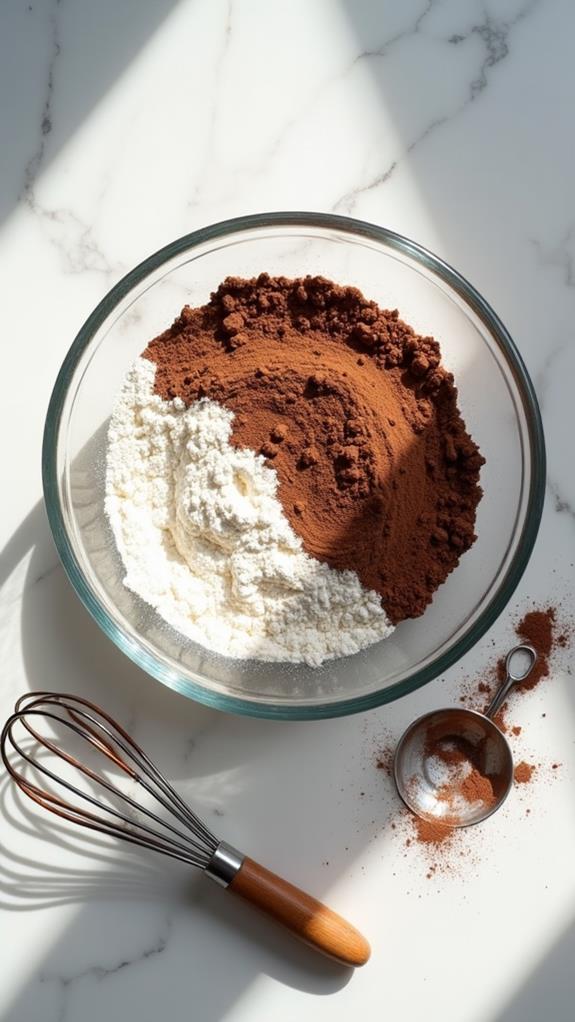
Sifting together the dry ingredients is a crucial step in creating your Chocolate Yule Log. You'll need to combine the all-purpose flour and unsweetened cocoa powder, ensuring they're well-mixed and free of lumps.
Start by placing a fine-mesh sieve over a large bowl. Measure out 1/2 cup (60g) of all-purpose flour and 1/3 cup (30g) of unsweetened cocoa powder, then pour them into the sieve.
Gently tap the side of the sieve with your hand, allowing the ingredients to fall through into the bowl below. This process aerates the dry ingredients, removing any clumps and creating a lighter texture in your final cake.
Once you've sifted all the flour and cocoa, use a whisk to blend them thoroughly. This extra step ensures even distribution of the cocoa throughout the flour, preventing pockets of bitter chocolate in your cake.
Step 4. Bake and Roll Cake
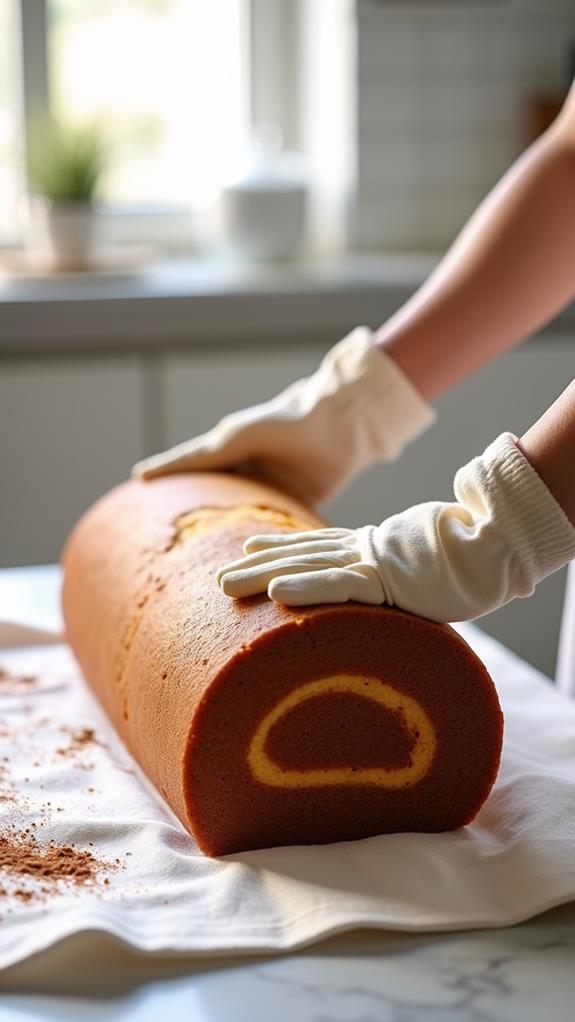
With your cake batter prepared, it's time to bake and shape your Yule Log. Preheat your oven to 350°F (175°C) and line a jelly roll pan with parchment paper. Carefully pour the batter into the pan, spreading it evenly to ensure uniform thickness.
Place the pan in the oven and bake for 12-15 minutes, or until the cake springs back when lightly touched.
Once baked, you'll need to work quickly while the cake is still warm. Dust a clean kitchen towel with cocoa powder and invert the cake onto it. Gently peel off the parchment paper, then roll the cake with the towel inside, starting from the short end. This process creates the log shape and prevents cracking.
Allow the rolled cake to cool completely on a wire rack, seam side down.
After cooling, carefully unroll the cake and remove the towel. Spread your prepared filling evenly over the surface, leaving a small border around the edges.
Re-roll the cake tightly, this time without the towel, and place it seam side down on your serving platter.
Step 5. Add Cream and Re-Roll
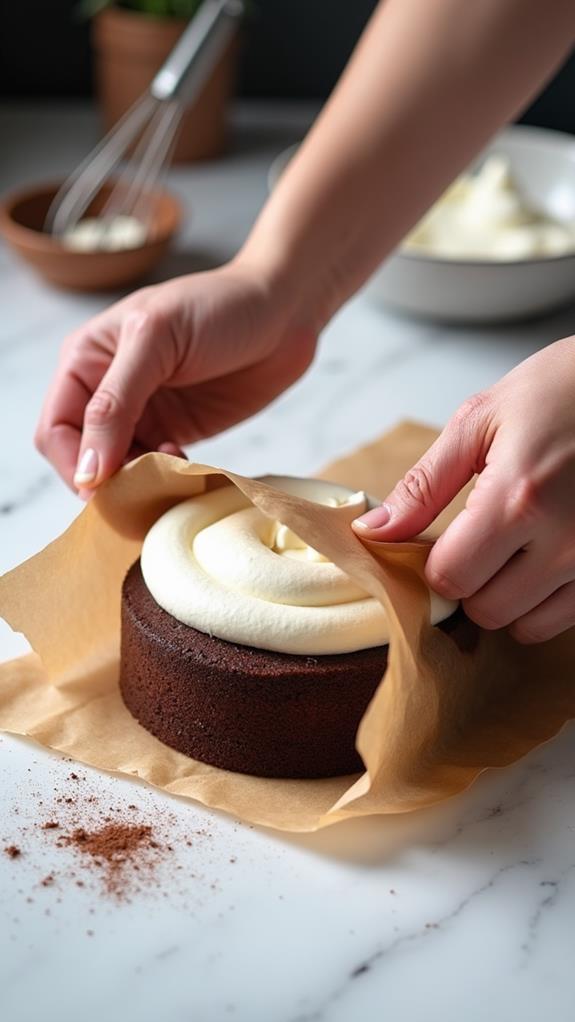
Now that your cake has cooled, it's time to add the creamy filling and re-roll your Yule Log.
Carefully unroll the cake, removing the parchment paper. Don't worry if there are a few small cracks; they'll be hidden by the filling.
In a clean bowl, whip the heavy cream until stiff peaks form. This should take about 3-5 minutes with an electric mixer.
Spread the whipped cream evenly over the unrolled cake, leaving a small border around the edges to prevent overflow.
Using the short end of the cake, begin rolling it tightly, incorporating the cream as you go. The spiral should be snug but not so tight that it squeezes out all the filling.
Once you've reached the end, position the cake seam-side down on your serving platter.
For a finishing touch, dust the entire log with cocoa powder using a fine-mesh sieve. This creates a bark-like appearance that's both beautiful and delicious.
If you're feeling creative, you can use a fork to create subtle texture lines along the surface, mimicking tree bark even more closely.
Final Thoughts
Three key points make this Decadent Chocolate Yule Log a winner for your holiday dessert table.
First, its simplicity allows you to create an impressive dessert without overwhelming complexity. With just five ingredients, you'll achieve a rich, moist cake that rivals more intricate recipes.
Second, the visual appeal of this log-shaped cake adds a festive touch to your table, making it a true centerpiece. The bark-like texture and optional decorations transform a simple dessert into a work of art.


